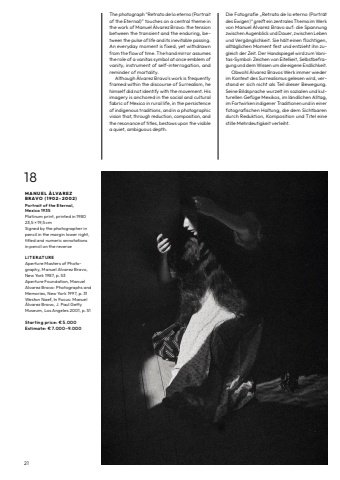Page 23 - Demo
P. 23
2118M A N U E L %u00c1 LVA R E Z B R AV O ( 1 9 0 2 %u2013 2 0 0 2 ) Portrait of the Eternal, Mexico 1935Platinum print, printed in 198023,5 %u00d7 19,5 cmSigned by the photographer in pencil in the margin lower right, titled and numeric annotations in pencil on the reverseLITERATUREAperture Masters of Photography, Manuel Alvarez Bravo, New York 1987, p. 53Aperture Foundation, Manuel Alvarez Bravo: Photographs and Memories, New York 1997, p. 31Weston Naef, In Focus: Manuel %u00c1lvarez Bravo, J. Paul Getty Museum, Los Angeles 2001, p. 51Starting price: %u20ac 5.000Estimate: %u20ac 7.000%u20139.000Die Fotografie %u201eRetrato de lo eterno (Portr%u00e4t des Ewigen)%u201c greift ein zentrales Thema im Werk von Manuel %u00c1lvarez Bravo auf: die Spannung zwischen Augenblick und Dauer, zwischen Leben und Verg%u00e4nglichkeit. Sie h%u00e4lt einen fl%u00fcchtigen, allt%u00e4glichen Moment fest und entzieht ihn zugleich der Zeit. Der Handspiegel wird zum Vanitas-Symbol: Zeichen von Eitelkeit, Selbstbefragung und dem Wissen um die eigene Endlichkeit.Obwohl %u00c1lvarez Bravos Werk immer wieder im Kontext des Surrealismus gelesen wird, verstand er sich nicht als Teil dieser Bewegung. Seine Bildsprache wurzelt im sozialen und kulturellen Gef%u00fcge Mexikos, im l%u00e4ndlichen Alltag, im Fortwirken indigener Traditionen und in einer fotografischen Haltung, die dem Sichtbaren durch Reduktion, Komposition und Titel eine stille Mehrdeutigkeit verleiht.The photograph %u201cRetrato de lo eterno (Portrait of the Eternal)%u201d touches on a central theme in the work of Manuel %u00c1lvarez Bravo: the tension between the transient and the enduring, between the pulse of life and its inevitable passing. An everyday moment is fixed, yet withdrawn from the flow of time. The hand mirror assumes the role of a vanitas symbol at once emblem of vanity, instrument of self-interrogation, and reminder of mortality.Although %u00c1lvarez Bravo%u2019s work is frequently framed within the discourse of Surrealism, he himself did not identify with the movement. His imagery is anchored in the social and cultural fabric of Mexico in rural life, in the persistence of indigenous traditions, and in a photographic vision that, through reduction, composition, and the resonance of titles, bestows upon the visible a quiet, ambiguous depth.


